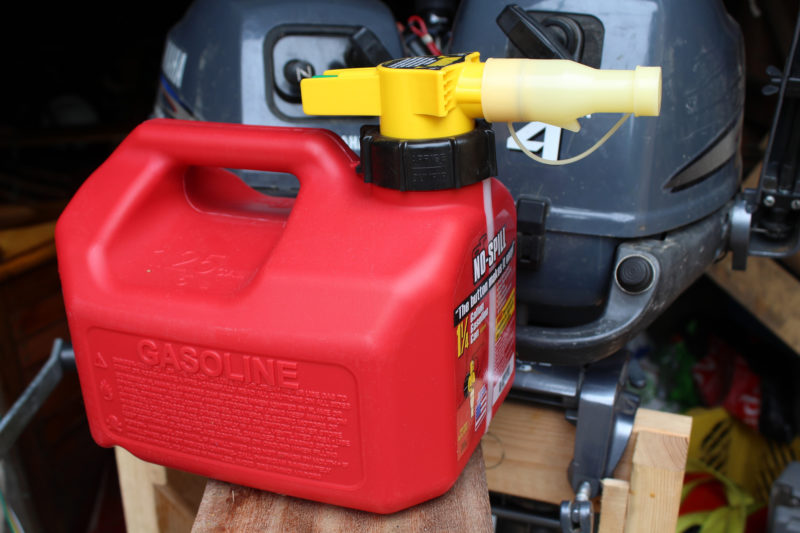 Photographs and video by the author
Photographs and video by the authorThe No-Spill gas can has several features that make it easier to avoid overfilling at the gas station and spills aboard the boat.
I’ve grown rather fond of the little 2.5-hp outboard motor I bought 15 years ago, not long after small four-strokes became available. I couldn’t see myself using a two-stroke, sneering as I do at the sight of outboards trailing an acrid blue fog. The four-stroke is easier on the environment—it has a two-star, “very low emission” rating from the California Air Resources Board (CARB)—so I’m always ashamed when I overfill the little one-quarter-gallon internal fuel tank and leave a rainbow sheen on the water and adding noxious vapors to the atmosphere.
The gas cans I’ve accumulated have all been messy affairs. The oldest had a nozzle that stored inside the can, which was dripping with gas from the get-go,and an air vent on the handle, which were banned in 2009. A more recent can has a flexible nozzle with a locking valve in the handle. Both cans require knowing when to stop pouring as the level of gas rises to the fuel-tank opening. At least with the newer model I can release the valve to stop the flow, but the gas keeps coming until the nozzle has drained itself. A third can has a spring-loaded nozzle you’d hook over the mouth of the tank, and the gas is supposed to stop flowing when it covers the end of the nozzle. It isn’t very reliable, so I no longer use it.
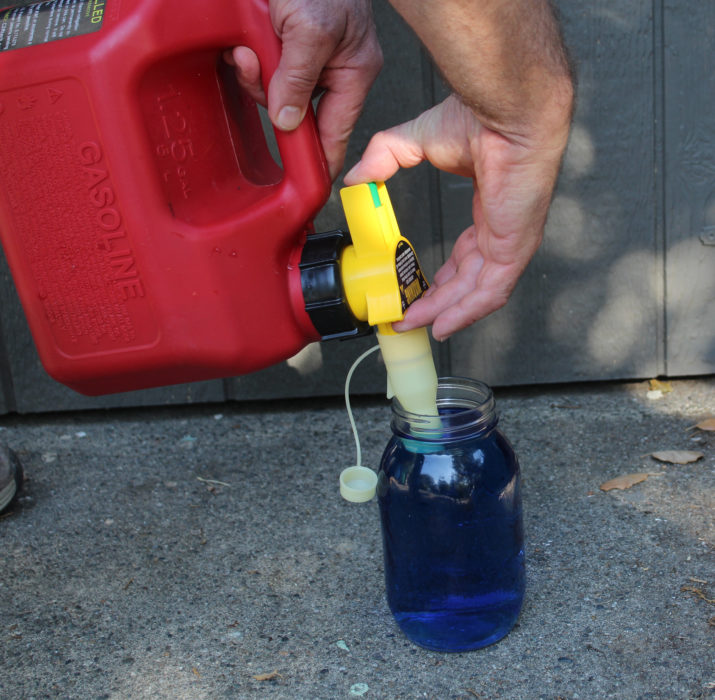
The nozzle has a flange, seen here resting on the left edge of the jar, that supports the weight of the can while pouring. With the valve’s button pressed, the fuel (colored water here) stops flowing when the it reaches the nozzle opening.
The No-Spill Gasoline Can has been a great improvement. I bought the 1.25-gallon size. There are 2.5- and 5-gallon sizes, more fuel than I usually need and too heavy and awkward to hold out over the transom to get to the motor. The HDPE can has notably thick walls and is quite rigid compared to my previous cans. It has a translucent vertical stripe at each end for a quick visual check of the level of fuel in the can. Its fill opening is 2-1/8″ in diameter, providing a much better view into the can when filling than the 1-3/8″ opening of my previous cans. Inside is a flame mitigation device (FMD), a white plastic insert like a skinny colander, that works to saturate the space with the gas vapor, crowding out the oxygen and making the mixture so rich that won’t ignite with the introduction of a spark or flame.
The locking ring for the cap has the usual ratchet to prevent children from opening the can. I found the ratchet difficult to disengage; its teeth are painfully sharp, so I sanded the points a little. When the cap is tightened, the ratchet goes well past the tab on the can. I’ve been used to having the caps on other cans come tight mid-ratchet. That’s what’s suggested by the instructions on the No-Spill can, but I found the lid sealed about an eighth of a turn beyond the engagement of the ratchet.
The nozzle has a cap that’s connected to keep it from getting lost. (If my older cans had caps, they’ve all taken a hike, allowing vapors to escape and grit to get in.) There’s also a molded flange to hook over the lip of the fuel tank’s fill spout, steadying the pour and taking the weight of the can.
Opposite the nozzle there is a green valve plunger. Depressing it allows gas to flow; releasing it stops it. The flow will also stop automatically if the fuel in the tank rises to cover the nozzle. A vent built into the nozzle is then prevented from letting air into the can, a partial vacuum is created, and the fuel stops flowing. After releasing the valve plunger, the pour spout can be removed from the tank without any spillage.
When I first tried the can, I filled it with water before filling it with gas. Several times the flow didn’t stop automatically. Air was somehow getting into the can, allowing it to continue to pour. I thought I hadn’t seated the cap thoroughly but that wasn’t the case. Air was getting through the hole at the top of the valve button when I didn’t have my thumb squarely over it. With my thumb sealing the hole, the can works perfectly.
The No-Spill can isn’t quite fool-proof, but it is sturdy, well designed, and can keep the fuel where it belongs—contained.![]()
Christopher Cunningham is the editor of Small Boats Monthly.
The No-Spill cans are available from numerous retailers and online sources. Prices range from $21 for the 1.25-gallon can to $36 for the 5-gallon.
Is there a product that might be useful for boatbuilding, cruising or shore-side camping that you’d like us to review? Please email your suggestions.




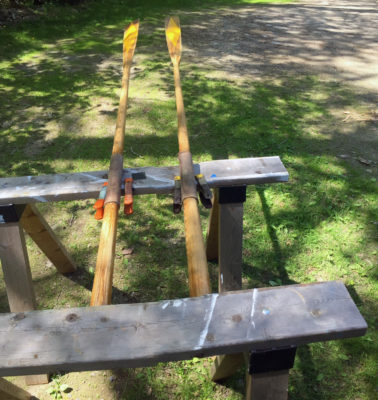
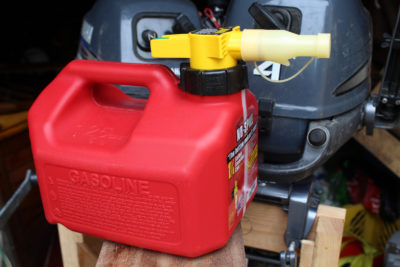
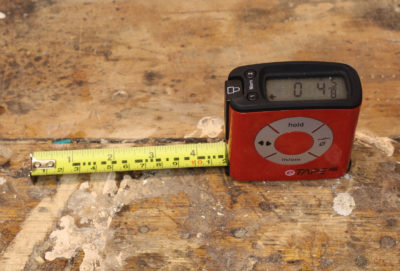
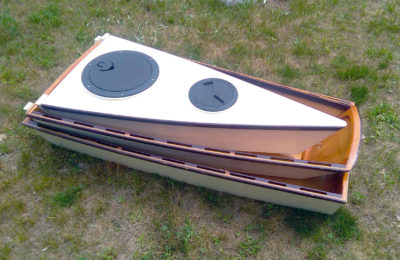
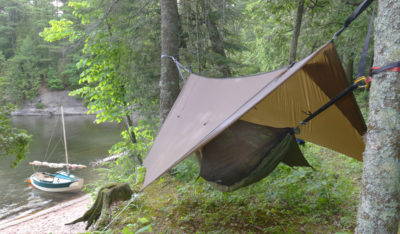
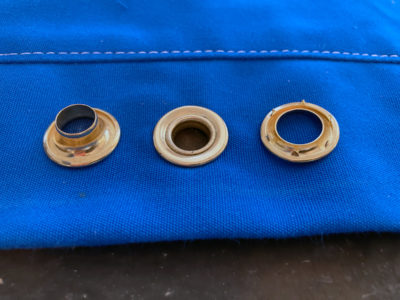
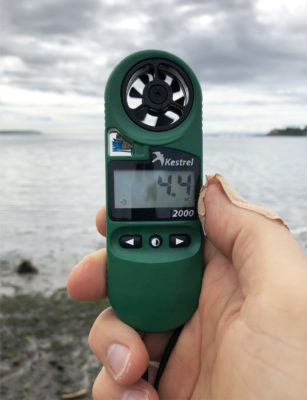
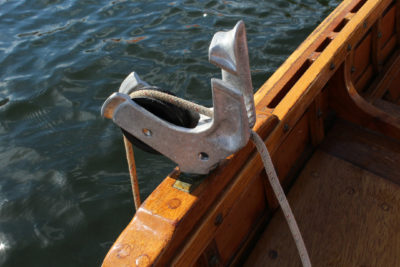
Looks like a great improvement over the current crop of cans in my barn. As you pointed out the other designs all have various shortcomings. Next new can purchase for me will certainly be a No-Spill. Thanks for the review and the video.
Pricy for a plastic gas can. I have owned many and thrown most away. But this can is the best I have ever
owned. Just like it says, no spill. I have two of the 5-gal versions.
I almost universally despise the newer style gas spouts. While they may work OK for smaller cans, try using a 5-gallon can to fill a container that is not firmly attached. I routinely use various size cans to fill generator and outboard tanks on electrofishing boats that I use for surveying fish populations for the University of Wisconsin’s Center for Limnology and I still prefer the older style. It takes two hands to use the newer style and hand placement is not always optimal for large cans.
Dave
David raises a good point about the size of the can. A gallon of unleaded gas weighs about 6 lbs. My 1.25 gallon can holds 7.5 lbs of fuel, the can itself is just under 1.5 lbs, so a full can is just 9 lbs. I can hold the full can, even with an outstretched arm, and operate it properly as long as I get the tip of my thumb set on the valve button, covering the hole. It’s easy to imagine that holding a 5-gallon can—30 lbs of gas plus the weight of the can—would be much more difficult.
Just a note concerning these “improved gas cans.” They all suck! I will not have one unless I have installed a vent cap where God intended. These caps can be bought on Amazon . My preferred method is to scour garage sales for the good ” old ” cans with vents . You can stuff these new Cali Compliant cans.
I purchased a couple No-Spill cans in the small size and have been using them for a year or so. They are perfect for chain saws, lawn blowers, outboard integral tanks, any gas-powered equipment with a small fuel tank. They definitely minimize gasoline liquid and vapor spillage. Nice environmental improvement and more convenient. Highly recommended in the small size.
However, the cap locking ratchet is difficult to release when filling the can. After several months of usage, I completely removed the sharp ratchet teeth with a quick snip with side cutters. My thought is a child who could loosen a tightened gas cap could also just as likely push the dispensing plunger and, can safety isn’t compromised with the ratchet removed.
I am disappointed that I did not think to offer a review of the No-Spill gas cans! We have 3 of them: 2 of the smaller 1.25 cans and a 5 gallon. The 5 gallon has a handle on top and on the end. We take the 1.25 gallon can out as reserve fuel for our auxiliary Suzuki 2 1/2 or Suzuki 6. And like Joe, we recently removed the ratchet stop, it was a little too efficient at keeping this large child from loosening the cap.
Cheers
Kent
Hi Chris,
I like the No-Spill gasoline can you reviewed in the September issue of SBM. There is another alternative for filling fuel tanks that we have used for 20 or so years.
We cruise in some areas where it’s difficult to get to docks for fuel. Cruising in a sailboat and needing little fuel, it seems a waste to tie up a fuel dock to obtain 10 or so gallons of fuel unless we also need a pump-out or fresh water.
So we purchased a couple of 5-gallon jerry cans that can be filled and then transferred to our on-board fuel tanks. To transfer the fuel, we use a siphon hose that easily transfers the fuel from the jugs to the boat’s tanks without spillage. The advantage is that you do not have to hold the jug nozzle and a can full of fuel to the tank’s fill opening. Instead, the bitter end of the hose is inserted and the valve end of the hose is jiggled up and down in the jerry can until the hose is is filled enough to begin siphoning. As the can empties you need to tilt the tank to get out the last drops of fuel.
We also use the siphon hose for our gas-guzzling center-console power boat, which uses about 5 gallons of fuel just to get to and from a marina selling non-ethanol gasoline. Instead, I have several 5-gallon jugs and get the non-ethanol gas at a local land-based gas station. These siphon hoses can be obtained at marine stores for about $11.